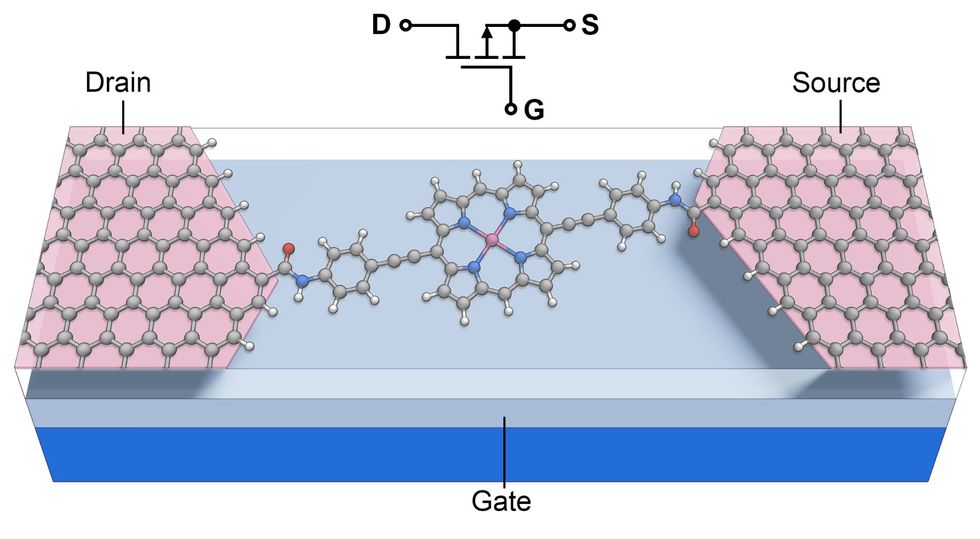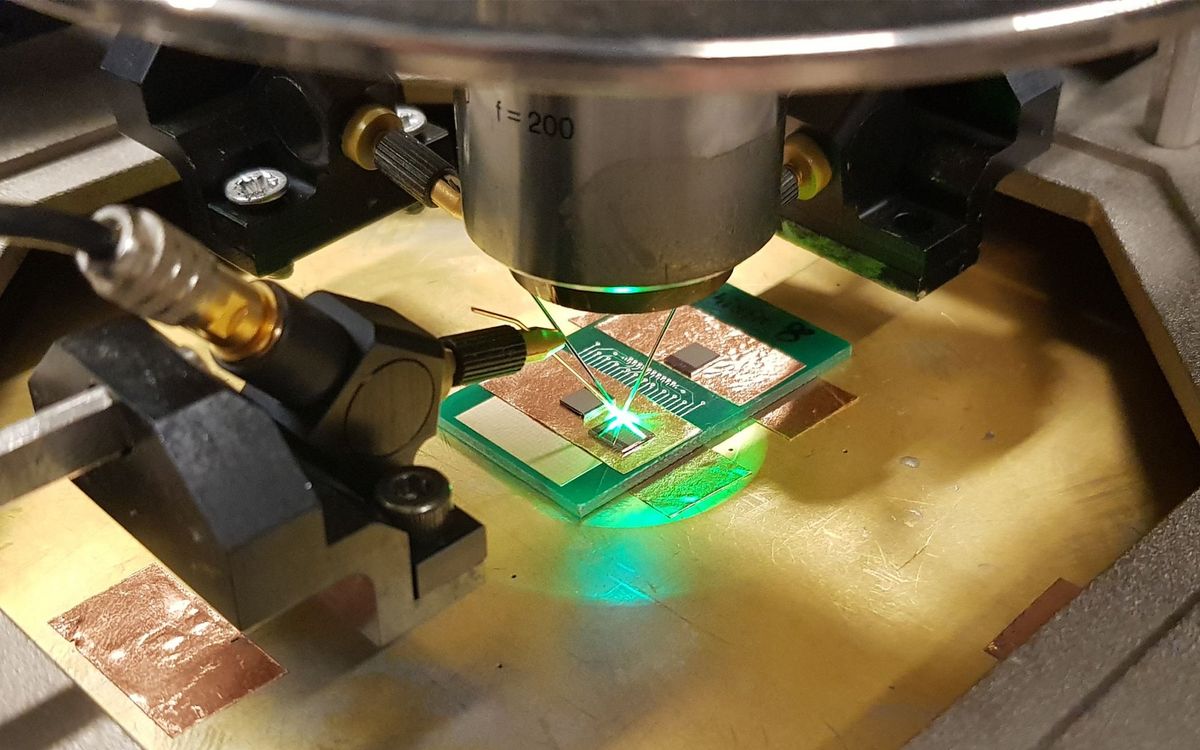As transistors are made ever tinier to fit more computing power into a smaller footprint, they bump up against a big problem: quantum mechanics. Electrons get jumpy in small devices and leak out, which wastes energy while degrading performance. Now a team of researchers is showing that it doesn’t have to be that way. With careful engineering, it’s possible to turn electrons’ quantum behavior into an advantage.
A team of English, Canadian, and Italian researchers have developed a single-molecule transistor that harnesses quantum effects. At low temperatures, the single-molecule device shows a strong change in current with only a small change in gate voltage, nearing a physical limit known as the subthreshhold swing. Getting near or beyond this limit will allow transistors to be switched with lower voltages, making them more efficient and generating less waste heat. The research team, including physicists at Queen Mary University of London, achieved this by taking advantage of how quantum interference alters the flow of current in single molecules.
“We’ve demonstrated, in principle, that you can use destructive quantum interference for something useful.” —Jan Mol, Queen Mary University of London
This design side steps the pitfalls of miniaturizing traditional transistors. “As transistors get smaller, there’s quantum tunneling of electrons from source to drain,” says James Thomas, a quantum technologist at Queen Mary University of London. “That means you can’t really turn it off,” he says. “It’s almost an inevitable effect of miniaturization.”
Another Electronic Path
Thomas and his colleagues wanted to offer electrons another path, so they carefully designed a single-molecule transistor to control their flow. The transistor is made up of a single zinc porphyrin molecule anchored at either end to graphene source and drain electrodes. The porphyrin is similar to structures found in hemoglobin and chlorophyll. The team chose it because it has good electronic properties and because they liken it to a chemical Lego block. It’s easy to stick on functional groups that help make the molecule soluble or chemically bind it to graphene. When a voltage is applied to a gate electrode, electrons can flow from one graphene electrode through the porphyrin molecule and into the other graphene electrode.
Due to the size and design of the porphyrin molecule and electronic behavior at the edges of the graphene electrodes, electrons don’t move through this single-molecule transistor like simple particles. Their wave nature dominates. When the transistor is switched on, electrons interfere constructively, reinforcing one another. When it’s off, electrons in the porphyrin channel interfere with each other. This destructive interference means the device has almost no leakage current.

Minimizing transistors’ subthreshhold voltage is one of the major hurdles in the electronics industry, says Latha Venkataraman, an applied physicist at Columbia University who was not involved with the work. “They get very close to the limit,” she says.
Lifetime has been a problem for single-molecule electronics. But the quantum-interference transistor can switch hundreds of thousands of times without getting damaged. Its performance is comparable to that of carbon-nanotube transistors, but its channel length is much shorter, because the molecule is just 2.1 nanometers long, says Thomas. Carbon-nanotube devices typically have channel lengths of 7–10 nm.
Building the quantum interference transistor took about 10 years, a team of chemists, materials scientists, and physicists—and patience.
“We’ve demonstrated, in principle, that you can use destructive quantum interference for something useful,” says project physicist Jan Mol of the Queen Mary University of London. Still, he and Thomas don’t expect their quantum interference transistor to be found in products anytime soon.
The Single-Molecule Road Ahead
“Individual transistors are not that useful,” says Thomas. The next step would be to connect multiple devices on a chip to build simple logic gates, then a simple computer, as has been done with carbon-nanotube transistors.
Such talk, says Thomas, is putting the cart before the horse. Researchers don’t know how to reliably make the graphene electrodes, whose atomic-level structure dictates device performance. “The structure of the graphene electrodes is so important,” says Mol. “You have to be very careful about the edges of the graphene.”
“The idea for this kind of transistor came about from scientific curiosity,” says Mol. His group is interested in looking at how electricity flows through molecules. Organic chemists know how to tailor molecules atom by atom. If scientists can figure out how to design a molecule just so, in order to act as a near-flawless channel in a transistor, they should be able to build it. Mol and others are trying to learn the molecular design rules that will make this possible. Building the quantum-interference transistor took about 10 years, a team of chemists, materials scientists, and physicists, and, he says, patience. Making devices built from these transistors will take a lot more work and patience.
The researchers described their work in a paper published this week in Nature Nanotechnology.
This article appears in the June 2024 print issue as “Molecular Transistor Takes Advantage of Quantum Interference.”
- A Quantum Drum Brings Quantum Mechanics to the Macroscale ... ›
- A Quantum of Sensing—Atomic Scale Bolsters New Sensor Boom ... ›
Katherine Bourzac is a freelance journalist based in San Francisco, Calif. She writes about materials science, nanotechnology, energy, computing, and medicine—and about how all these fields overlap. Bourzac is a contributing editor at Technology Review and a contributor at Chemical & Engineering News; her work can also be found in Nature and Scientific American. She serves on the board of the Northern California chapter of the Society of Professional Journalists.



